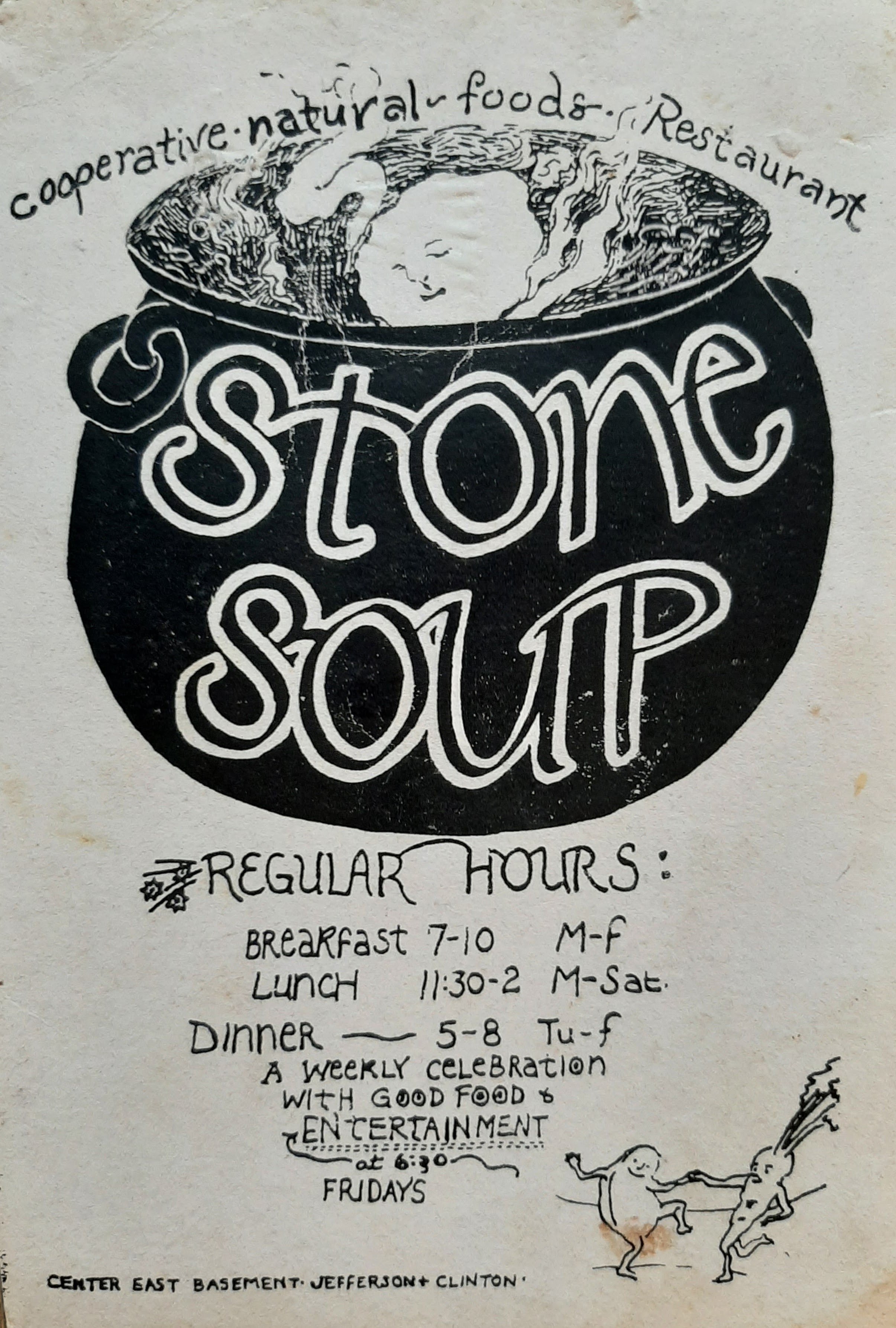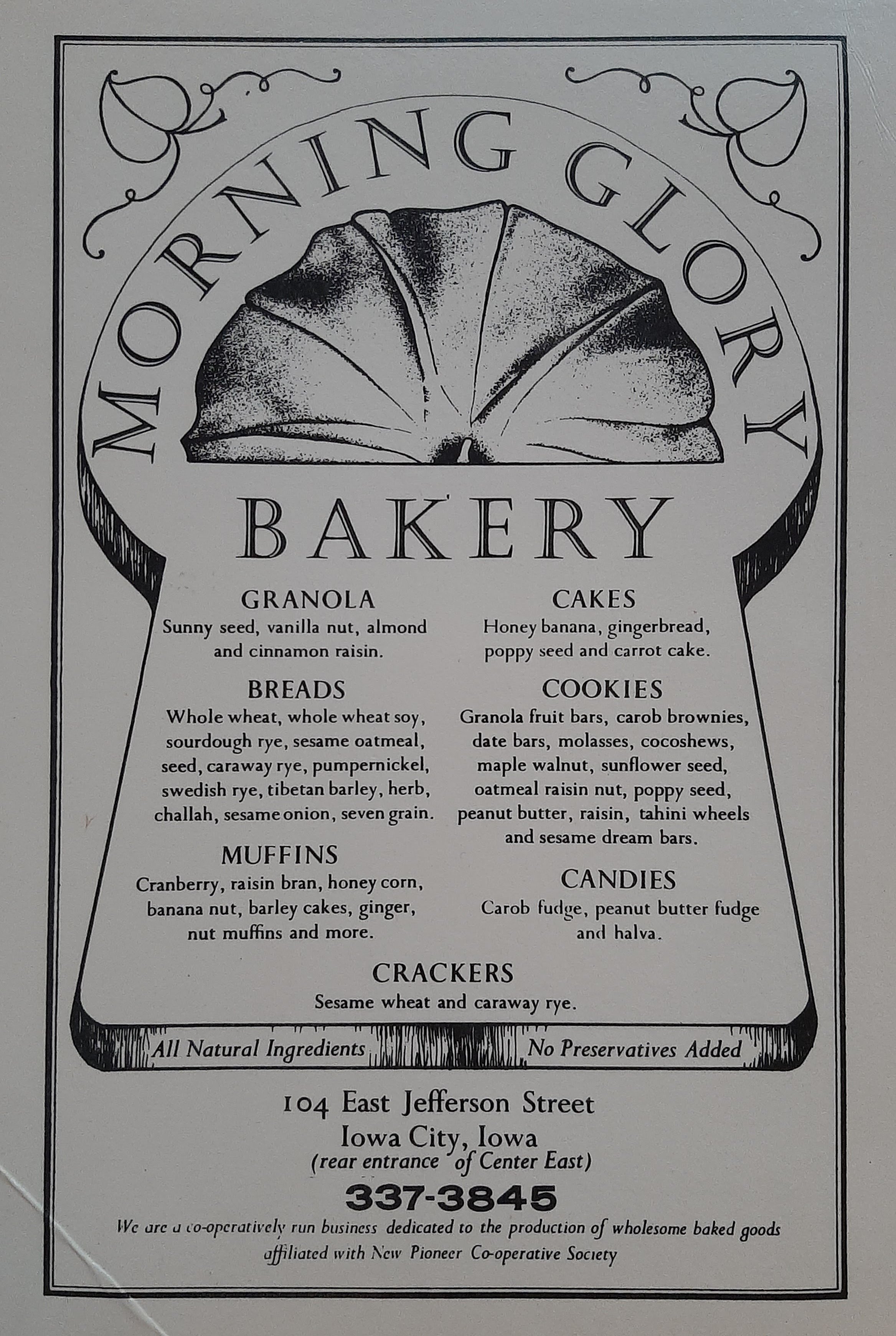Baker (Jobs of My Youth #5)
“When I cook, another body comes alive. Not the body of walking or typing, not the body of sitting or talking, certainly not the body of driving or TV-watching, but the body of cooking: a body alive to flavors and fragrance, a body ready to touch and be touched, a body which eats with eyes and nose as well as mouth….. Hands awaken, boundless with their own knowledge, picking up, handling, putting down.” –Edward Espe Brown, The Tassajara Bread Book
When I moved to Iowa City in the fall of 1975 to start classes at the University of Iowa, I immediately discovered I could stop by Stone Soup Restaurant at lunch time, wash dishes for an hour, and get paid with a hot lunch. Stone Soup was a cooperative natural foods vegetarian restaurant located in the basement of Center East, a square three-story brick building on the corner of Clinton and Jefferson streets.
I was drawn to the idealism and activism of the people involved in the food co-op movement. Stone Soup had become a gathering place for vegetarians, artists of all stripes, hippies and nonconformists, feminists and left-wing politicos. One could get a “home-cooked” meal for a couple dollars and stick around to meet and talk with interesting folks. As a regular volunteer, I was invited to a staff meeting where a proposal to add a night baking shift was on the agenda. When the staff agreed to do this, I expressed interest in one of the baker jobs and was hired on the spot. The easiest job application and interview ever.
I did have some baking experience. I started baking bread when I was in high school, often giving away my loaves to friends or bringing them to parties. My girlfriend at the time still fondly remembers the loaf I left on her front porch with a romantic note. And when I started hitchhiking, I cultivated the habit of baking bread to thank the people whose home I was crashing at.
Of course, the Stone Soup bakery operated on a larger scale, but it retained that sense of reciprocity. We were baking for not only the restaurant but also New Pioneer Co-op, then located less than a mile away on the corner of Gilbert and Prentiss streets. Our shift would usually start at ten o’clock, just as the dinner crew was finishing their cleanup, and wrap up at five in the morning. The two or three staff signed up for each shift would bake up to 100 one-pound loaves of bread, ten or fifteen pounds of our two types of granola (regular and deluxe), a batch or two of cookies, and on some nights, ten dozen beanburgers, made from a recipe featuring cooked and mashed soybeans.
The core of the bakery staff were hired in short order. We each worked three or four shifts a week. Pat had just blown in from the Santa Cruz Mountain community of Mount Hermon (population 715 hippies, less one).[1] Cheryl grew up in a Mennonite family just south of Iowa City, raised to value practices that support environmental sustainability. Edith, a university student majoring in science and minoring in studio art, had an array of kitchen skills learned from her Italian American mother. Michael was a jazz clarinetist studying composition in the university’s School of Music. Nancy was a native Iowa Citian and an avid organic gardener. I had a crush on all the women I worked with, and six years later, I married one of them – that woman from Santa Cruz.[2]
Center East was the former home of St. Mary’s School, which served grades one through twelve from 1893 to 1968 and then was sold to the Newman Catholic Student Center in 1975. The Newman Center staff was repurposing the building as a community space. Stone Soup Restaurant rented the cafeteria kitchen and a small adjoining dining room for a nominal fee. The large basement cafeteria was occasionally transformed into a space for benefit dances[3] featuring the Magic Goat Band, which was mostly composed of New Pioneer and Blooming Prairie Cooperative Warehouse staff. Upstairs was the Free Store, where one could address their clothing needs or grab a sweater on an unexpectedly cold day. Clemens Erdahl and Sue Futrell helped set up an office for United Tenants for Action, offering free legal aid to oppose predatory and deadbeat landlords. Barbara Welch, working on a doctorate in Communication Studies, had converted a classroom, with its tall windows and dark woodwork, into the Iowa City Yoga Center.
The restaurant had inherited the school cafeteria’s large gas stoves and acquired a used industrial bread dough mixer. We religiously followed the recipes in The Tassajara Bread Book,[4] written in the late 1960s by Edward Brown, a student at the Tassajara Zen Mountain Retreat tucked away in central California’s Los Padres National Forest. We’d mix lukewarm water, yeast, honey or molasses, milk powder, and whole wheat flour, forming a sponge the consistency of a thick slurry. We’d give that time to rise and then add oil, salt, more flour, and other ingredients particular to the bread we were making.
We always made a batch or two of Whole Wheat and three or four other breads, such as Swedish Rye, Sunflower Seed, Challah, Oatmeal, Poppy Seed, Cinnamon Raisin. At the beginning of the shift, we’d check out the dinner leftovers, on the chance that they’d inspire us to concoct a new bread recipe. My favorite was “pizza bread,” made by sprinkling a thin layer of marinara sauce and mozzarella over the dough before rolling it into a loaf.
When the dough had risen to twice its size, we would punch it down and begin to pinch off one-pound hunks, using a kitchen scale to measure. Then we’d get to it, loafing on the two long low countertops that filled the center of the kitchen. It was work that felt like play, work filled with tactile joy. We all developed similar methods for shaping the loaves: kneading the dough, flattening it into a large square to remove any remaining air bubbles while flipping and patting it to smooth its surface, then folding it once, folding in its ends, rolling it into a loaf shape, and pinching the seams shut. We’d drop the loaves into seasoned pans strapped together in groups of four and set them atop the warm stove to rise one last time.
Joy of baking - Cheryl and Pat at the Stone Soup Restaurant bakery.
As the night wore on, the sensory stimuli would become more robust, helping us power through the wee hours. We’d start pulling steaming bread out of the ovens, removing the brown loaves from the pans and putting them on cooling racks in the dining room. While the loaves were still hot, we’d run a stick of butter over the top crust. Some granola might also be cooling, some peanut butter cookies, perhaps a batch of cinnamon rolls.
Because the restaurant was rarely closed and one could get a meal for working in the kitchen, it drew street people, many of whom were named Rick – Rick the Hobo, Red Rick, Crazy Rick. The bakery’s aromas also attracted attention. My friend Tony, who lived nearby and kept odd hours, might stop by to hang out and share a new poem. The basement kitchen’s windows were at sidewalk-level along the route from the downtown bars to the eastside dorms. In the summer, a few weak box fans would move the heat around, and we often stripped down to the minimal amount of clothing (although we at least kept our aprons on). A lot of foot traffic passed by at two o’clock, after the bars closed. When the windows were open, we’d hear our share of catcalls. Believe me, we gave as good as we got.
The restaurant had a portable record player and maybe twenty well-worn albums, most of their edges decorated with dried bread dough. Those albums provided the soundtrack to our work – Linda Ronstadt’s Heart Like a Wheel, Stevie Wonder’s Innervisions, the Grateful Dead’s American Beauty, Joni Mitchell’s For the Roses, Jackson Brown’s Late for the Sky. After the baking was done and the loaves had been bagged up with their handmade labels, we’d sit down at one of the dining room tables and pull out a runt loaf. We’d slice thick hot chunks of bread, slather them with melting butter, and enjoy the flavor of our work. We’d talk about the night, or the approaching day, while listening to songs like J. J. Cales’s “After Midnight” or Bonnie Raitt’s “Nothing Seems To Matter.”
After my shift, I’d usually go upstairs to the yoga studio to sleep. Greeted by the lingering scent of incense, I’d lie down on a yoga mat and snooze until someone from the breakfast shift came up to wake me for my nine o’clock Intro to Philosophy class that fall semester. I held this job for a full year, until I left for Mexico the next fall. When I returned in the spring, the bakery was being relocated and revamped as Morning Glory Bakery. I helped its staff move into two classrooms upstairs, lugging out all but two of the heavy slate blackboards, power-sanding those buckled oak floors down to their light brown grain, removing 75 years of Catholic school memories. In their place, we offered a passionate energy inspired by the aromas and traditions of baking bread.
Footnotes:
[1] After her ’67 Dodge Dart ferried her cross-country, its passenger seats were removed so the car could haul baked goods to New Pioneer and 50-lb. sacks of whole wheat flour, brown rice, etc. from Blooming Prairie Warehouse.
[2] Off the top of my head, I can think of at least three other married couples who either worked alongside each other or met at Stone Soup.
[3] To support non-profit community organizations such as Emma Goldman Clinic, Free Medical Clinic, Dum-Dum Daycare Center, Willowwind School, as well as the restaurant.
[4] Except that we multiplied the ingredients by 8 to achieve economies of scale.




